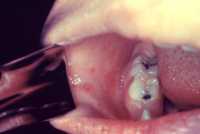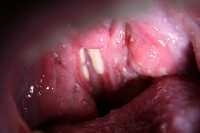Childhood Abuse More Likely With Male Caregiver, especially Mother’s Boyfriend
MedicalResearch.com Interview with:
Amanda Fingarson, DO Attending Physician, Child Abuse Pediatrics Ann and Robert H. Lurie Children’s Hospital of Chicago Assistant Professor of Pediatrics Feinberg Northwestern School of Medicine
MedicalResearch.com: What is the background for this study? What are the main findings?
Response: Child physical abuse is a substantial pediatric public health issue, with significant morbidity and mortality. Studies have found that men, particularly children’s fathers and mothers’ boyfriends are common perpetrators of physical abuse. There is still a lack of knowledge, however, about the specific caregiver features that increase a child’s risk for physical abuse.
Our study design was unique, in that it was a multi-center study that compared young children with abusive and accidental injuries. Our primary finding was that abuse was much more likely when a male caregiver was present, and the resulting injuries were more likely to be severe or fatal. The presence of the mother’s boyfriend was the riskiest scenario, with the highest likelihood of abuse. Similarly, we found that caregiver relationships of less than 1 year increased the odds of abuse. Overall, the likelihood of abuse with female caregivers was much lower, with the exception of female babysitters. A final important finding of our study was that caregiving arrangements that were different than usual at the time of injury were at increased risk of abuse, suggesting that a stable and consistent caregiver is also important. (more…)
Sexting Linked to Increased Sexual Activity and Substance Abuse Among Teenagers
 Camille Mori, B.A. (hons)
M.Sc. candidate
Clinical Psychology Program
Determinants of Child Development Lab
University of Calgary
MedicalResearch.com: What is the background for this study?
Response: Sexting, which is the sharing of sexual messages, images, or videos over technological devices, has recently become a cause for concern among parents, teachers, and policy makers. However, the research on sexting among youth is still in early stages, and evidence of the risks associated with sexting is inconsistent. One way to resolve discrepancies in the field is to conduct a meta-analysis, which statistically summarizes existing research. We conducted a meta-analysis in order to examine the association between sexting and sexual activity (having sex, multiple sexual partners, and lack of contraception use). The associations between sexting and mental health related variables, including delinquent behaviour, substance use, and depression/anxiety were also examined.
(more…)
Camille Mori, B.A. (hons)
M.Sc. candidate
Clinical Psychology Program
Determinants of Child Development Lab
University of Calgary
MedicalResearch.com: What is the background for this study?
Response: Sexting, which is the sharing of sexual messages, images, or videos over technological devices, has recently become a cause for concern among parents, teachers, and policy makers. However, the research on sexting among youth is still in early stages, and evidence of the risks associated with sexting is inconsistent. One way to resolve discrepancies in the field is to conduct a meta-analysis, which statistically summarizes existing research. We conducted a meta-analysis in order to examine the association between sexting and sexual activity (having sex, multiple sexual partners, and lack of contraception use). The associations between sexting and mental health related variables, including delinquent behaviour, substance use, and depression/anxiety were also examined.
(more…)Measles Vaccine in Early Childhood Associated with Long Term Health and Cognitive Benefits
Decrease in Obesity Among Young US Children Enrolled in Special Supplemental Nutrition Program 2010-2016
Keep Your Up Cosmetics and Out of Sight of of Kids
Store all personal care products safely: up, away and out of sight - in a cabinet that can be locked...
More Scooters Means More Head and Face Injuries
Children with High Risk AML: Intensification of Induction II Chemotherapy and Liberalization of Stem Cell Donor Source does not Improve Outcomes
Canadian ERs Use Less Pediatric Diagnostic Imaging Than US
Larotrectinib (VITRAKVI® ): Efficacy and Safety in Pediatric TRK Fusion Cancer Patients
Laundry Detergent Packets Still Poison Kids, Despite Tougher Standards
Sudden Infant Death Can Occur in Child Seats, esp When Not In Car and Adult Asleep
Pre-Visit Electronic Screening Helps Doctors Counsel Their Adolescent Patients
Collaboration and Teamwork Allowed Reduction in Unintended Extubations in Neonatal ICU
E-Cigs: New Source of Second-Hand Smoke for Children
 MedicalResearch.com Interview with:Jenny L. Carwile, ScD, MPH
Department of Medicine
Maine Medical Center
Portland
MedicalResearch.com: What is the background for this study? What are the main findings?
Response: Although e-cigarette aerosols are commonly perceived to be "harmless water vapors" they contain numerous potentially harmful chemicals including volatile organic compounds like formaldehyde, nicotine, heavy metals, and ultrafine particulates. Non-users can be exposed to these chemicals through secondhand exposure.
We found that in the US 4.9% of adults who lived in a household with children were current e-cigarette users. (more…)
MedicalResearch.com Interview with:Jenny L. Carwile, ScD, MPH
Department of Medicine
Maine Medical Center
Portland
MedicalResearch.com: What is the background for this study? What are the main findings?
Response: Although e-cigarette aerosols are commonly perceived to be "harmless water vapors" they contain numerous potentially harmful chemicals including volatile organic compounds like formaldehyde, nicotine, heavy metals, and ultrafine particulates. Non-users can be exposed to these chemicals through secondhand exposure.
We found that in the US 4.9% of adults who lived in a household with children were current e-cigarette users. (more…)



























